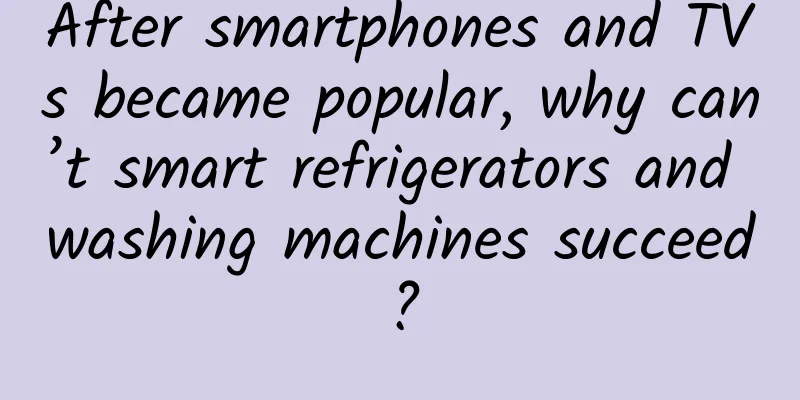After smartphones and TVs became popular, why can’t smart refrigerators and washing machines succeed?

|
The term "the first year of smart home" has been mentioned for several years, and every year it seems that the time has come. However, almost everyone thinks that the smart era is just around the corner, but it has never come to us. The mobile phone industry has been around for 10 years, while the TV industry has been around for only three or four years. Both have entered an era of being swept by the trend of intelligence. However, the "smart home" that can control a light is still far from being popularized. Not to mention that even the white goods camp, which has a status no less than that of TV in the home and has brought great convenience to consumers' lives, has not ushered in the spring of intelligence. But recently, with the support of the China Home Appliances and Consumer Electronics Expo (AWE), the voices of "white appliances are about to enter the smart era" and "the time is ripe for white appliances to become smart" have been heard again. However, whose interests are being catered to behind the smartization of white appliances? Intelligence and consumption upgrade: the truth behind “bundled sales” With the improvement of people's living standards and the acceleration of the country's urbanization process, "consumption upgrade" has become the hottest topic. We are in the third wave of consumption structure upgrading, and we deeply feel the rapid growth of entertainment, culture, transportation, education, culture, housing, consumer electronics and other related industries driven by transformation. At the same time, people's higher requirements for quality of life have also put forward higher requirements for these industries accordingly. Competition in these projects is particularly fierce in the consumer electronics field. For white goods, they can help users save a lot of labor and time, which is crucial to improving the quality of life. However, the brutal price war caused by homogeneous competition has extremely compressed the profits of the white goods industry. According to the statistics of CMM in 2016, we can see that the sales volume of the white goods industry fell by 1.9%, and the total market value continued to decline, down 2.9%, showing the phenomenon of "general decline in the industry, and rise in high-end products". It is not difficult to imagine how difficult it is for non-high-end brands. But what is even more tragic is that since the end of last year, due to the shortage of some white appliance parts and the price increase, the soaring copper resource price, and the volatile RMB exchange rate, the survival of white appliance companies has become increasingly difficult. So we have seen that since last year, major white appliance manufacturers have begun to try to impact the mid-to-high-end home appliance market in an attempt to release the unbearable profit pressure. Relying on product intelligence and taking advantage of consumption upgrading is the lifeline for white appliance manufacturers to escape from the deficit dilemma. The trend of smart technology has not yet opened up to white goods Standing on the edge of a cliff waiting for the wind, the result could be flying up or falling off the cliff. Smart technology has put Apple on the altar and sent traditional TV to the grave. As a result, there seems to be a blind worship of smart technology among the people. However, it should be noted that the concept of smart technology has been proven to be premature in many fields, and many consumers' smart ideals have been identified as false needs, such as smart wearable devices that have already cooled down globally. However, the existing intelligent application scenarios of white goods are mostly unrealistic. They ignore user habits and are suspected of forced "intelligence". The rapid development of mobile computing has made mass production of chips, systems and codes as simple and cheap as cabbage. However, as long as we get rid of the superficial understanding that "intelligence is networking", "installing a screen" and "installing an APP on a mobile phone", we will not see practical usage scenarios and killer products. The so-called intelligence is just a disguised money-making tool for manufacturers with ulterior motives. The vicious consumption of the concept of "intelligence" by white goods companies is harmful to the future of the industry. Entering the high-end market, the value still needs to return to users So, what strategy should white appliance brands adopt when launching an offensive into the mid-to-high-end camp? The answer is simple. Only by satisfying user needs, solving user pain points and upgrading user experience will users be willing to pay a higher price. The easiest demands to meet are those for design, lifespan, materials and appearance. These demands can be achieved through simple, low-cost R&D investment. Most manufacturers are doing this and competition is still very fierce. The deeper level of competition is the insight into user pain points, and the competition of R&D costs and capabilities to implement technology. For example, just before the opening of AWE, TCL held a new product launch conference and announced a pollution-free drum-in-drum washing machine and an integrated variable-frequency air-cooled refrigerator. Both products were specially developed to meet the strong user demands discovered by TCL during user surveys. They are designed for specific usage scenarios in reality and solve problems that users often face. The research and development of TCL's pollution-free barrel-in-barrel washing machine is dedicated to solving the secondary pollution of pulsator and drum washing machines, as well as the secondary pollution between clothes. It adopts a barrel-in-barrel structure. When washing clothes, the washing programs of the large barrel and the exclusive barrel are operated in different areas without interfering with each other. The large barrel adopts a new patented fully sealed barrel structure, a washable split all-steel pulsator and an integrated all-steel inner drum bottom to solve the problem of pollution of clothes by washing machines. Not only does it allow consumers to say goodbye to hand-washing underwear and cross-contamination of laundry, and enjoy a truly healthy washing and care life, it even makes the whole society begin to pay attention to public health issues. TCL's integrated variable frequency air-cooled refrigerator has achieved three major breakthroughs based on professional air cooling with 17 core technologies and 205 patents. It pioneered the integrated variable frequency technology and launched the integrated variable frequency air-cooled refrigerator. Through the scientific design of cold air distribution and the integrated variable frequency refrigeration control technology, it has changed the defects of traditional air-cooled refrigerators. This refrigerator has a special independent storage area to provide special storage space for precious red wine, high-end tea, Chinese medicinal materials, and women's cosmetics. It is tailor-made for treasure collections and can intelligently control the temperature and humidity that are most suitable for red wine storage. It is used to store special ingredients such as red wine and cosmetics, so that all kinds of treasures can be stored exclusively. It provides users with the best food storage solution. Compared with ordinary air-cooled refrigerators, its advantages of "fast cooling, small temperature difference, super energy saving, and low noise" are very obvious. Consumption upgrading is a huge change we are experiencing, and it also provides unprecedented business opportunities for current companies. However, to achieve the transformation into a high-end brand, it still requires solid research, accurate grasp of users' inner needs, and hard research and development, rather than simply giving the product a "smart" hat and calling it a day. As a winner of Toutiao's Qingyun Plan and Baijiahao's Bai+ Plan, the 2019 Baidu Digital Author of the Year, the Baijiahao's Most Popular Author in the Technology Field, the 2019 Sogou Technology and Culture Author, and the 2021 Baijiahao Quarterly Influential Creator, he has won many awards, including the 2013 Sohu Best Industry Media Person, the 2015 China New Media Entrepreneurship Competition Beijing Third Place, the 2015 Guangmang Experience Award, the 2015 China New Media Entrepreneurship Competition Finals Third Place, and the 2018 Baidu Dynamic Annual Powerful Celebrity. |
<<: Chrysler Pacifica hybrid version was reported to be discontinued
Recommend
Be careful! Don't play with your phone like this, the consequences are quite serious!
Expert of this article: Xu Qibin, associate chief...
Case study: How to make information flow advertising in the beauty industry more effective?
Women love beauty, forever Regarding why women lo...
From 30 million to 2.6 million, what benefits can domestically produced MRI machines bring to the people?
Audit expert: Meng Meng Associate Researcher, Ins...
App fission promotion: N kinds of techniques are fully analyzed!
In an era where traffic is king, social platforms...
Without it, food would become expensive and unpalatable, but many people are afraid of it.
As modern people pay more and more attention to h...
Event operation and promotion: How to plan the core gameplay?
As usual, let me give you a definition: Operating...
User operation: a new way to increase user base through fission!
What methods were used to attract new users, resu...
Mimi Meng is so expensive, and vivo signed a one-year contract. How else can brands and self-media cooperate?
Last night, a golden sentence appeared in Mi Meng...
Is it because the seaweed that doesn’t want to be used as nori is not good seaweed, that it is expensive?
One night, Tadpole accidentally saw a video of a ...
What are the differences between the SEO of Baidu, Sogou, 360, and Shenma search engines?
For these commonly used search engines in China, ...
Tencent's latest data: QQ's monthly active users are less than half of WeChat's
On May 20, Tencent released its first quarter fin...
Construction and operation of private domain traffic!
When some brands engage in " private domain ...
WeChat iOS 7.0.12 is officially launched, dark mode is here
WeChat version 7.0.12 is officially launched. Aft...
What is the difference between electric toothbrushes that are 100 times more expensive? The key is to look at this parameter
Electric toothbrushes are now very common. When p...









